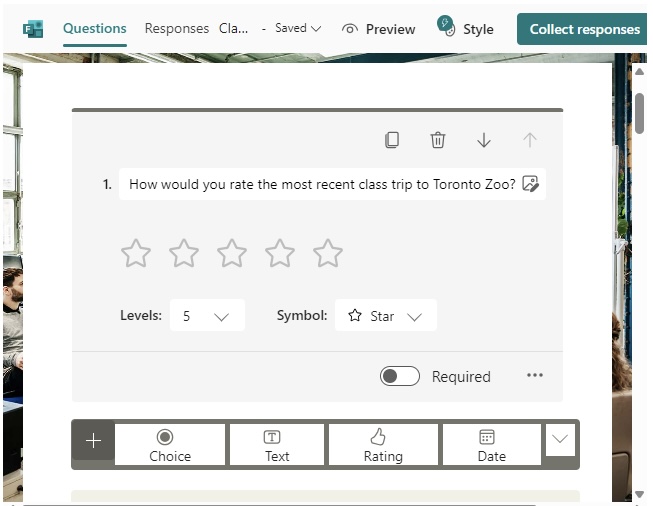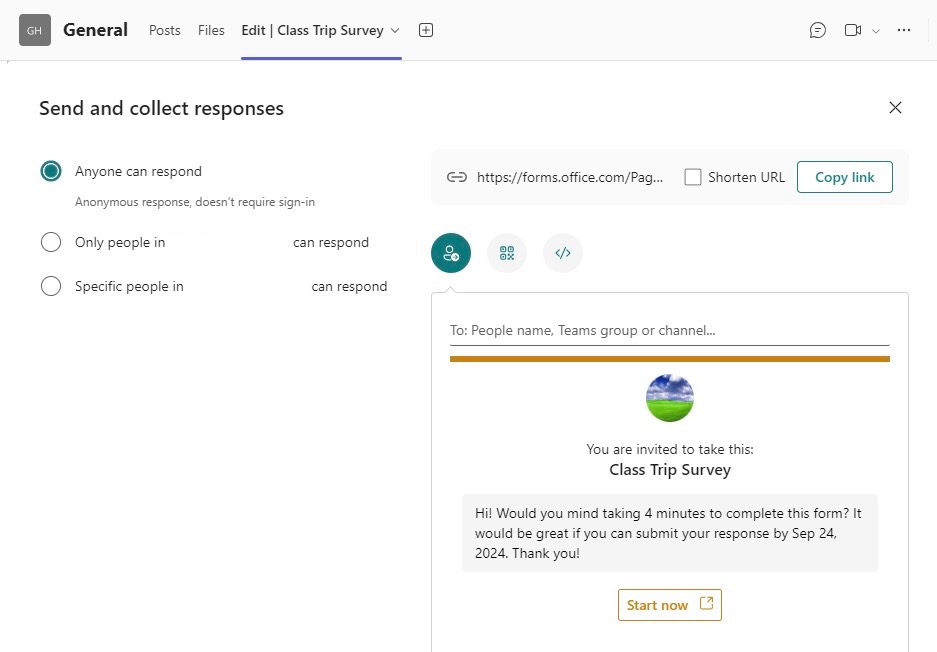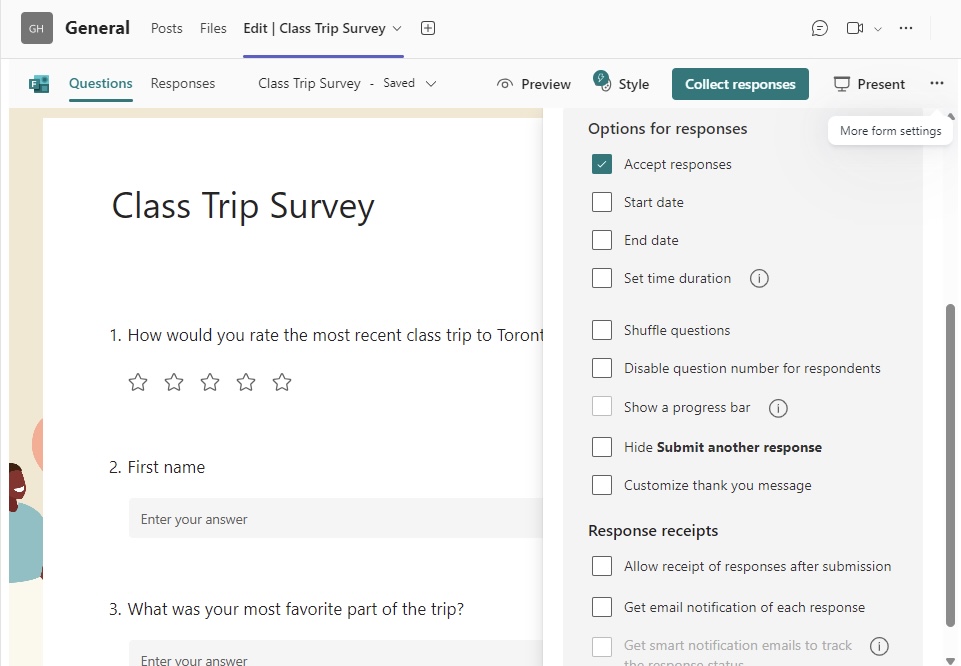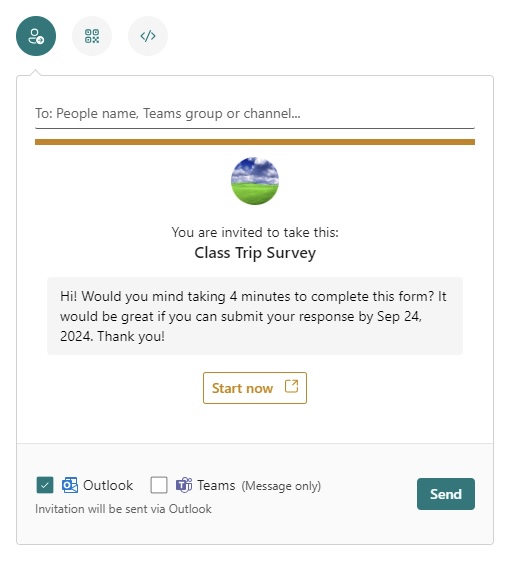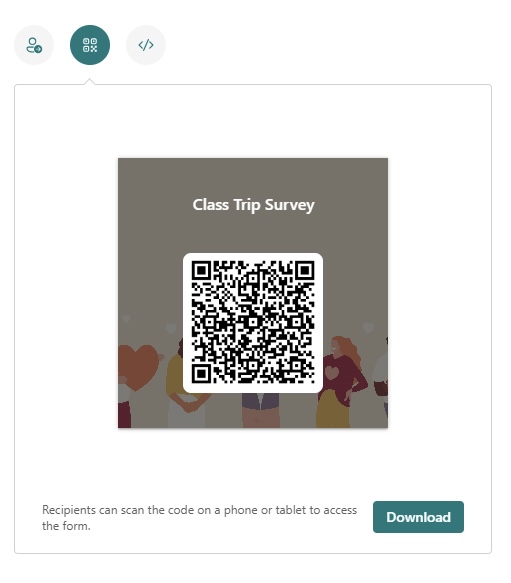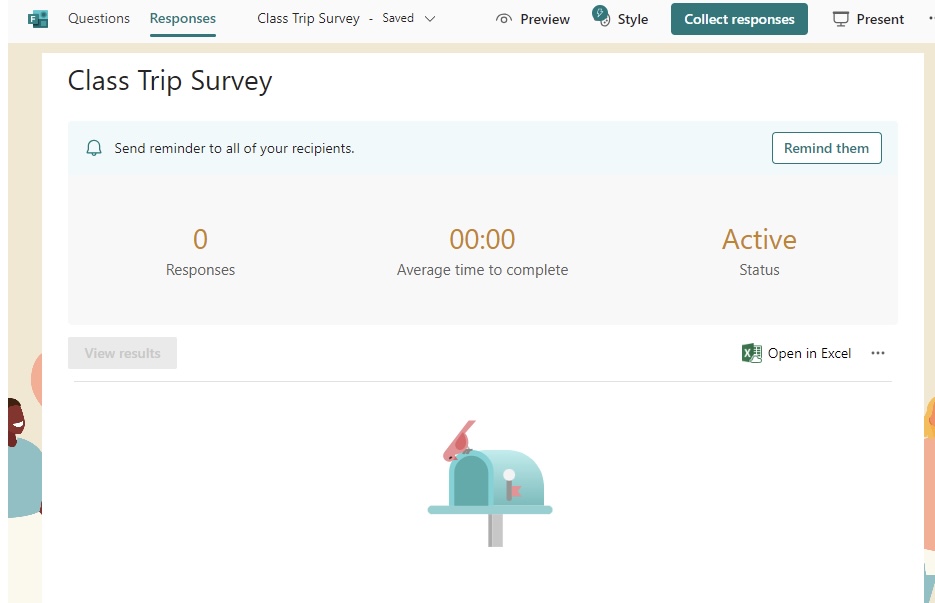In my experience, the smooth integration of Microsoft Forms into Microsoft Teams has created an efficient environment for communication and data gathering. I’ve noticed that Microsoft Forms offers a seamless way to create a survey in Microsoft Teams. Even polls and quizzes can directly be used within a Teams channel or chat. This integration allows us to skip the cumbersome process of managing external links and streamline the sharing of surveys within our teams.
Key Takeaways
- Initiate survey creation in Microsoft Teams by navigating to the appropriate channel or chat, clicking the “+” icon, and selecting “Forms.” You can then choose to create a new form or use a pre-made template, customizing it with various question types, themes, and your organization’s logo.
- Ensure your survey questions are clear and concise, with meaningful response options. Add branching logic for tailored follow-ups based on previous answers, and personalize the survey with theme colors and background images to enhance engagement.
- Once your survey is ready, distribute it by clicking “Send,” sharing a direct link, adding it to a tab for easy team access, or inviting participants as team/channel members. Analyze responses through the Forms summary report or export data to Excel for in-depth analysis, respecting respondent anonymity for honest feedback.
The Advantages of Conducting Surveys Within Teams
Conducting surveys directly within Microsoft Teams, I’ve found, offers a trove of benefits. Paramount among these is the convenience it provides, effectively reducing the steps to collect valuable data. Since our teams are already conversing and collaborating within Teams, deploying surveys in the same space minimizes disruption and encourages higher response rates. Plus, there’s real-time response tracking—a feature I consider invaluable for staying up-to-date on feedback as it comes in, enabling us to react and adapt swiftly.
Moreover, the collective intelligence of a workgroup can be tapped more effectively when surveys are conducted within the familiar workspace of Teams. This familiarity, coupled with easy accessibility, encourages participation and fosters a more inclusive atmosphere where everyone’s opinions are heard, valued, and can drive change.
Table of Contents
Step-by-Step Survey Creation
Starting Your Microsoft Teams Survey
When I begin creating a survey in Microsoft Teams, the first step is to navigate to the desired channel or chat. I click on the “+” icon to add a new tab, then select “Forms” from the array of available apps. 
Here’s where the ease of use truly shines: Microsoft Forms is embedded right there without the need to juggle between applications. 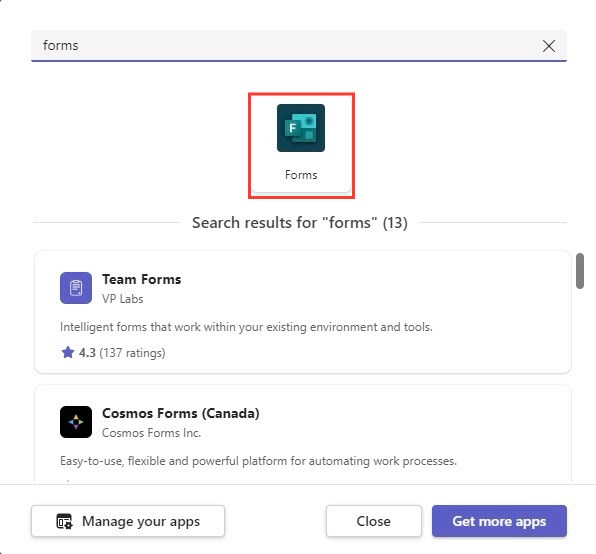
Crafting Effective Survey Questions
Drafting survey questions is a pivotal step that requires particular attention to detail. 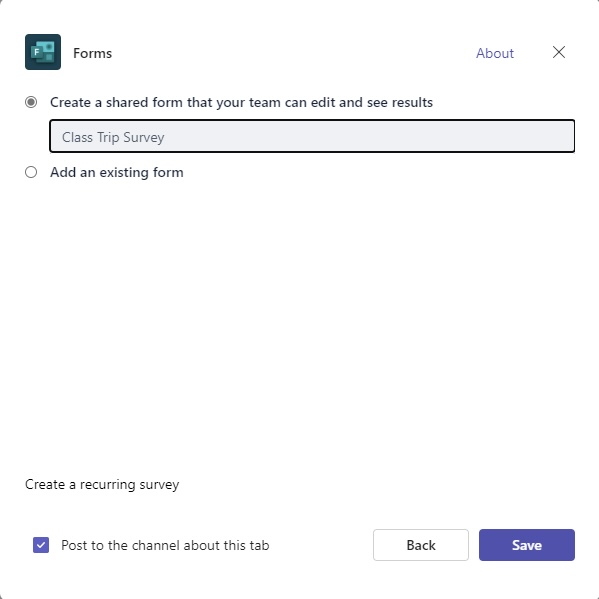
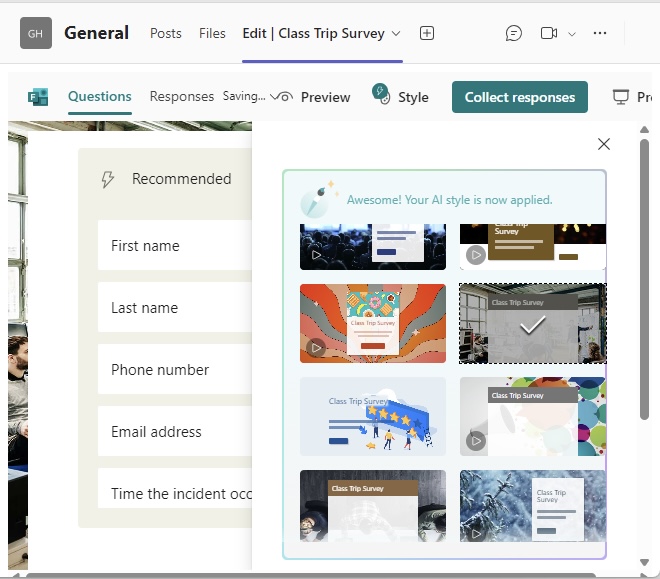
The format of the questions has a substantial effect, too. I prefer a mix of multiple-choice for statistical analysis and open-ended questions for qualitative insights. 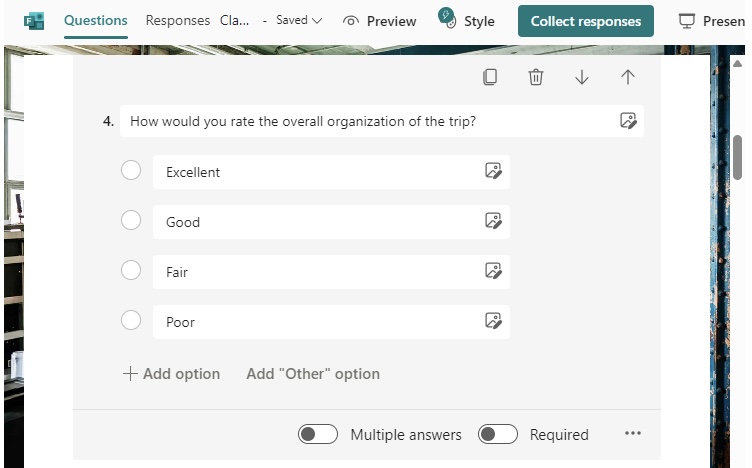
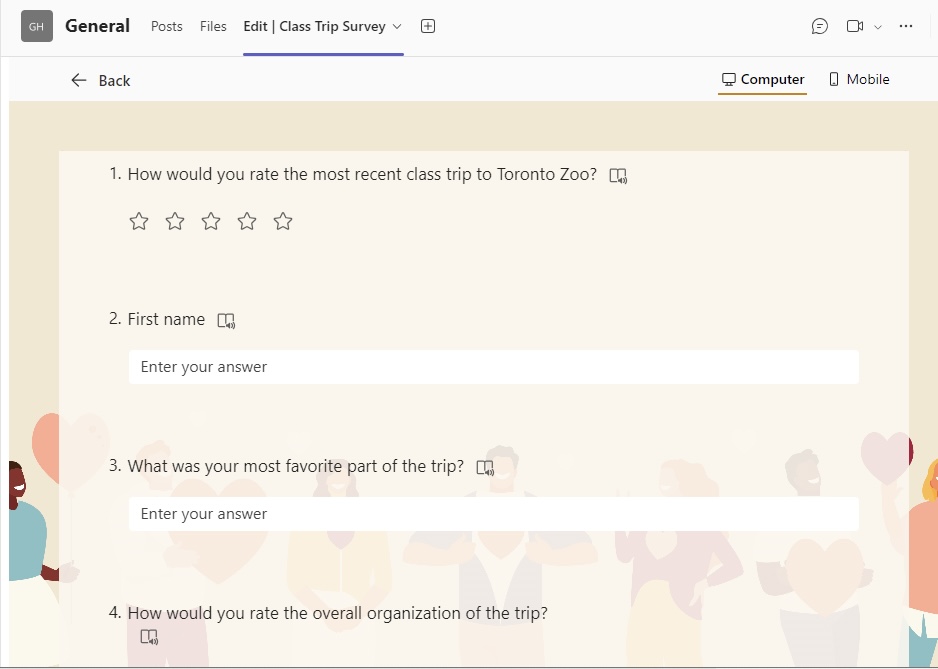
Customizing Your Survey
Tailoring Settings for Targeted Results
To tailor the survey settings for targeted results, I delve into the ‘Settings’ menu in Microsoft Forms. This is where I can specify who has permission to fill out the survey, deciding between anyone with the link or only people within my organization. If confidentiality or targeted insights are necessary, I might restrict access to specific individuals or groups.
Adjusting the settings to get just the feedback I’m after is a flexible process. I can opt to keep responses anonymous to encourage frank answers or collect names if follow-up is needed. There’s also the choice to set start and end dates for survey availability to ensure timely responses, along with options to allow or disallow response edits and to shuffle questions for each participant.
The settings are the control room of my survey. With Microsoft Forms, I have the power to align the survey precisely with my targeted results, whether it’s open feedback, controlled group responses, or collecting data over a set period.
Employing Templates for Quick Setup
I’ve often leveraged templates to jumpstart the survey creation process. Microsoft Forms provides a selection of stylish templates that I can customize according to my needs, which is especially helpful when time is of the essence. While Microsoft Forms may offer a more modest selection compared to other platforms like SurveySparrow—which boasts over a thousand upon sign-up—even these readily available skeletons save precious time.
The templates serve as a starting point, offering pre-conceived structures for common survey types like event feedback or customer satisfaction. From there, we can tweak and tailor them, adding a personal touch or organizational branding that resonates with our audience. In my practice, these templates have shaved hours off the development process, enabling me to focus more on crafting the right questions and less on building from scratch.
Distribution and Collaboration
Inviting Participants to Take the Survey
When it comes time to invite participants, I make the process as intuitive as possible. After scheduling the survey, participants receive a direct message through Microsoft Teams with a prompt to complete it. The direct approach ensures no one is left out and boosts completion rates since Microsoft Teams is already part of their daily workflow.
Knowing that not everyone is always online or available, I find it effective to send a follow-up announcement in the relevant Teams channel. I include a brief and compelling message about the importance of the survey, aiming to engage and encourage participation. This redundancy is not bothersome; rather, it reinforces the significance of their input and minimizes the chance of the survey being overlooked.
Collaborative Editing with Team Members
Collaborative editing with team members can streamline the survey creation process significantly. Once I’ve initiated the process and formulated a draft, sharing my Microsoft Form for collaborative purposes is just a click away. By clicking on the ‘Share’ button, I select ‘Share to collaborate.’ A link is then generated, which I can send directly to my teammates.
The collaborative feature in Microsoft Teams brings diverse perspectives to the table, allowing us to refine questions and ensure the survey is comprehensive and void of any biases or blind spots. What’s convenient is that as we discuss the survey within Teams, our conversation remains alongside our form, neatly captured in a context that aids decision-making and edits, preserving the flow of our collective thinking.
I always ensure we define clear roles among collaborators to avoid conflicts or overlap in editing. This approach streamlines the collaboration while maintaining the integrity of the survey content.
Gathering and Analyzing Feedback
Collecting Responses Effectively
For collecting responses effectively, my approach in Microsoft Teams is proactive and designed to maximize engagement. I monitor the response rate regularly, tapping into the built-in analytics to identify any lags or issues in real-time and making adjustments to the survey circulation if needed.
I also take advantage of reminders within Teams, which I time strategically. Reminding participants to complete the survey just before the deadline, for instance, often results in a final surge of responses. Accessibility is rarely an issue within Teams, but should any participant have trouble, I ensure support is readily available.
I keep an eye on the feedback as it comes in, noting any patterns or outstanding comments that may require immediate action. This ongoing analysis allows me to remain agile, making data-driven decisions and demonstrating to my team that their feedback isn’t just heard—it is integral to our collective success.
Analyzing Data for Informed Decisions
Once I’ve gathered all the responses, analyzing the data to make informed decisions is my next priority. The ‘Responses’ tab in Microsoft Forms provides an overview, but I often delve deeper. I use the ‘Open in Excel’ feature to export the data for a comprehensive analysis—this allows me to spot trends and perform more complex statistical analysis if needed.
Sometimes, my objective extends to understanding the nuances behind the data. Here, employing the HR Analytics Module of Teamflect, for instance, can be valuable, especially when integrated within Microsoft Teams. It empowers me to create custom reports and dashboards, offering advanced visualization tools that simplify the interpretation of complex data sets and reveal the story behind the numbers.
Real-time tracking has proven indispensable for actionable insights, particularly when assessing the effectiveness of initiatives and identifying opportunities for team growth. Whether it’s understanding employee engagement or gauging product feedback, the ability to break down and analyze survey results is fundamental to driving strategic decisions based on solid evidence.
FAQs About Creating Surveys in Microsoft Teams
Can you do a survey in Microsoft Teams?
Yes, we absolutely can conduct surveys in Microsoft Teams. The platform conveniently integrates tools like Microsoft Forms, allowing us to create, distribute, and analyze surveys without leaving Teams. It’s a streamlined process that fits well within our daily workflow, enhancing team engagement and feedback collection.
Absolutely, conducting a survey in Microsoft Teams is not only possible but also highly efficient. Microsoft Teams facilitates this through its seamless integration with Microsoft Forms, as well as options for polls and third-party apps, enabling us to gather feedback quickly and effectively within the platform.
Can You Customize a Microsoft Teams Survey?
Indeed, we can customize a Microsoft Teams survey to fit our specific needs. Utilizing Microsoft Forms, we can tailor the design with themes, add our company branding, choose different types of questions, and set rules for responses. These customizations ensure that our survey resonates with the team and elicits the most useful feedback.
How Do You Share a Microsoft Teams Survey with External Users?
To share a Microsoft Teams survey with external users, I simply change the settings within Microsoft Forms to allow anyone with the link to respond. Then, I distribute the shareable link via email or any other preferred communication platform to reach the intended participants outside my organization. This ensures inclusivity and broader feedback.
John Michaloudis is a former accountant and finance analyst at General Electric, a Microsoft MVP since 2020, an Amazon #1 bestselling author of 4 Microsoft Excel books and teacher of Microsoft Excel & Office over at his flagship MyExcelOnline Academy Online Course.

